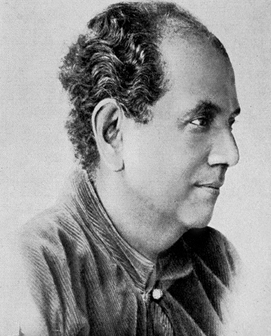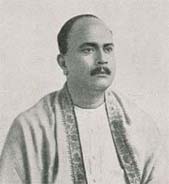Related Research Articles

Ratan Parimoo, born in Kashmir, is an art historian, art educator, pedagogue, artist and former director of the Lalbhai Dalpatbhai Museum, Ahmedabad. Ratan Parimoo was one of the founder members of Baroda Group.

The National Gallery of Modern Art (NGMA) is the premier art gallery under Ministry of Culture, Government of India. The main museum at Jaipur House in New Delhi was established on 29 March 1954 by the Government of India, with subsequent branches at Mumbai and Bangalore. Its collection of more than 17,000 works by 2000 plus artists includes artists such as Thomas Daniell, Raja Ravi Verma, Abanindranath Tagore, Rabindranath Tagore, Gaganendranath Tagore, Nandalal Bose, Jamini Roy, Amrita Sher-Gil as well as foreign artists. Some of the oldest works preserved here date back to 1857. With 12,000 square meters of exhibition space, the Delhi branch is one of the world's largest modern art museums.

The Bengal School of Art, commonly referred as Bengal School, was an art movement and a style of Indian painting that originated in Bengal, primarily Kolkata and Shantiniketan, and flourished throughout the Indian subcontinent, during the British Raj in the early 20th century. Also known as 'Indian style of painting' in its early days, it was associated with Indian nationalism (swadeshi) and led by Abanindranath Tagore (1871–1951), and was also being promoted and supported by British arts administrators like E. B. Havell, the principal of the Government College of Art and Craft, Kolkata from 1896; eventually it led to the development of the modern Indian painting.

Abanindranath Tagore was the principal artist and creator of the "Indian Society of Oriental Art". He was also the first major exponent of Swadeshi values in Indian art. He founded the influential Bengal school of art, which led to the development of modern Indian painting. He was also a noted writer, particularly for children. Popularly known as 'Aban Thakur', his books Rajkahini, Buro Angla, Nalak, and Khirer Putul were landmarks in Bengali language children's literature and art.
Paresh Maity is an Indian painter. He is a prolific painter in a short career span. In 2014, Government of India conferred upon him its fourth-highest civilian award the Padma Shri.
Writers Workshop is a Kolkata-based literary publisher founded by the Indian poet and scholar Purushottama Lal in 1958. It has published many new Indian authors of post-independence urban literature. Many of these authors later became widely known.

Francis Newton Souza was an artist of modern Indian painting, a founding member of the Bombay Progressive Artists' Group his style exhibited both decadence and primitivism.

Ranjit Hoskote is an Indian poet, art critic, cultural theorist and independent curator. He has been honoured by the Sahitya Akademi, India's National Academy of Letters, with the Sahitya Akademi Golden Jubilee Award and the Sahitya Akademi Prize for Translation. In 2022, Hoskote received the 7th JLF-Mahakavi Kanhaiyalal Sethia Award for Poetry.
Indian English poetry is the oldest form of Indian English literature. Henry Louis Vivian Derozio is considered the first poet in the lineage of Indian English poetry followed by Rabindranath Tagore, Sri Aurobindo, Sarojini Naidu, Michael Madhusudan Dutt, and Toru Dutt, among others.

Ganesh Pyne was an Indian painter and draughtsman, born in Kolkata, West Bengal. Pyne is one of the most notable contemporary artists of the Bengal School of Art, who had also developed his own style of "poetic surrealism", fantasy and dark imagery, around the themes of Bengali folklore and mythology.

Ananda Lal is an Indian academic and theatre critic. He is the son of Purushottama Lal, founder of Writers Workshop, one of India's oldest creative writing publishers, established in 1958. He is a former Professor of English and Coordinator, Rabindranath Tagore Studies Centre (UGC), at Jadavpur University, Calcutta and has now retired from active service. He currently heads Writers Workshop, translates from Bengali to English, is a theatre critic for The Times of India (Calcutta). While he was a professor at Jadavpur, he regularly directed plays for the Department of English with students in the cast and crew.
Bina Sarkar Ellias is a poet. She is editor, designer and publisher of International Gallerie, a global arts and ideas journal (www.gallerie.net) founded by her in 1997. She is also an art curator, having curated several important exhibits of renowned artists. https://mumbaimirror.indiatimes.com/opinion/city-columns/bina-sarkar-the-cave-woman/articleshow/59865389.cms

The modern Indian art movement in Indian painting is considered to have begun in Calcutta in the late nineteenth century. The old traditions of painting had more or less died out in Bengal and new schools of art were started by the British. Initially, protagonists of Indian art such as Raja Ravi Varma drew on Western traditions and techniques including oil paint and easel painting. A reaction to the Western influence led to a revival in primitivism, called as the Bengal school of art, which drew from the rich cultural heritage of India. It was succeeded by the Santiniketan school, led by Rabindranath Tagore's harking back to idyllic rural folk and rural life. Despite its country-wide influence in the early years, the importance of the school declined by the 'forties' and now it is as good as dead.

Raman Siva Kumar, known as R. Siva Kumar, is an Indian contemporary art historian, art critic, and curator. His major research has been in the area of early Indian modernism with special focus on the Santiniketan School. He has written several important books, lectured widely on modern Indian art and contributed articles to prestigious international projects such as the Art Journal, Grove Art Online or The Dictionary of Art, Oxford University Press.

Kala Bhavana is the fine arts faculty of Visva-Bharati University, in Shantiniketan, India. It is an institution of education and research in visual arts, founded in 1919, it was established by Nobel laureate Rabindranath Tagore.

Atul Prasad Sen was a Bengali composer, lyricist and singer, and also a lawyer, philanthropist, social worker, educationist and writer.

Laxman Pai was an Indian artist and painter. He was a principal of the Goa College of Art, a post he held from 1977 to 1987. Pai was a recipient of several awards including India's third highest civilian honour of Padma Bhushan, awarded by the Government of India.

Sunayani Devi was an Indian painter born into the aristocratic Tagore family in Calcutta, West Bengal. She was a self taught artist, with no academic training in art. Inspired by her brothers, Abanindranath Tagore, Gaganendranath Tagore, and Samarendranath Tagore, she started painting only at the age of 30. She was married at the age of 12 to the grandson of Raja Ram Mohan Roy.
References
- 1 2 3 4 5 P., Dipti (August 2012). "The Versatile Virtuoso - Srimati Lal". Fusion Life. New Delhi. pp. 58–60.
- 1 2 Siddiqui, Rana (19 December 2003). "Arrival of the disciple...". The Hindu .
- 1 2 Sanyal, Manoj Kumar; Ghosh, Arunabha (1 June 2009). Culture, Society and Development in India: Essays for Amiya Kumar Bagchi. Hyderabad: Orient Blackswan.
- ↑ Kotoor, Gopikrishnan (5 February 2012). "Dear dad..." The Hindu .
- ↑ Joshi, Ruchir (28 November 2010). "BEYOND THE ORDINARY - The calligrapher of Calcutta-45". The Tribune .
- ↑ Habib, Shahnaz (5 December 2010). "P Lal obituary". The Guardian .
- ↑ Sen, Amreeta (14 June 1998). "Fire & Ice". The Statesman (India) .
- ↑ Sen, Amreeta (April 1997). "Eloquent Colours". The Statesman (India) .
- ↑ Ghosh, Labonita (10 May 2004). "Kolkata's Genesis Art Gallery 'contemporises' Mona Lisa". India Today .
- ↑ "Mona Lisa gets an Indian look". The Times of India . 7 May 2004.
- ↑ Uma Parkash (15 June 2012) "Benedictions", Friday Gurgaon. Retrieved 25 September 2013.
- ↑ Sanyal, Amitava (9 April 2010). "Francis Newton Souza: How the artist's libido guided him in art as in life". Hindustan Times .
- ↑ Georgina Maddox (6 July 2012) "Emerging out of Francis Newton Souza's shadow: Srimati Lal", India Today . Retrieved 25 September 2013.
- ↑ Baiju Parthan (1 December 2012) "Last Supper and Other Tales", Marg Magazine (see last line of article).